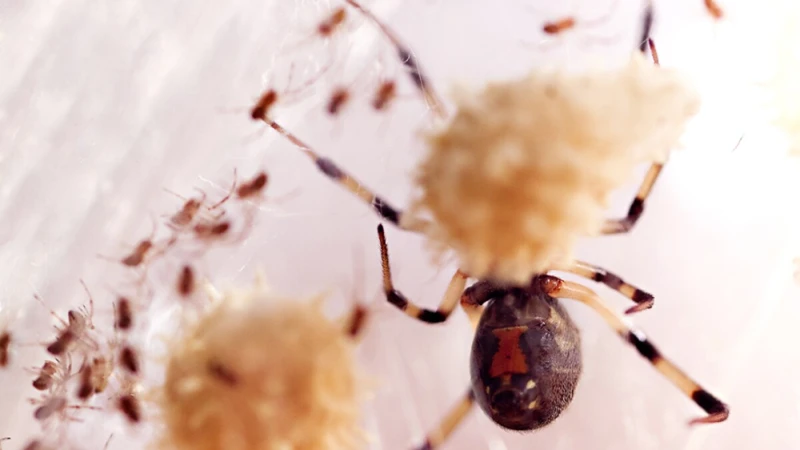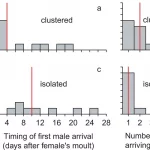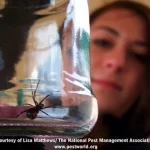As humans, when we think of territoriality, we often envision property lines, fences, and boundary markers. However, territoriality in the animal kingdom takes on an entirely different meaning. Black widow spiders, for instance, are known for their territorial behavior, which raises the question: what role do genetics play in this behavior? In this article, we’ll dive into the fascinating world of black widow spider territoriality and explore the influences of genetics, environment, and mating on this intriguing behavior. So, let’s get tangled up in the complex web of the black widow spider’s territoriality.
What is Black Widow Spider Territoriality?
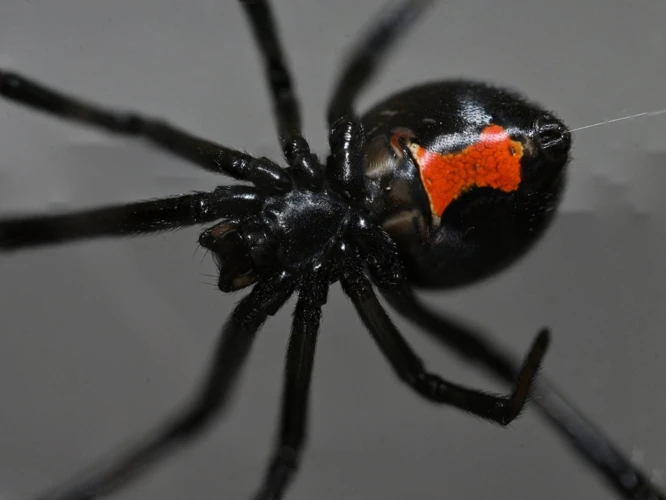
Understanding the behavior of black widow spiders is a fascinating topic of research. Among the behaviors that have attracted the attention of biologists is the territoriality of these spiders, which plays an essential role in their survival and reproductive success. Black widow spider territoriality is an intricate behavior that involves the defense of a particular area, and it has been observed in both males and females of various ages. To better understand the intricacies of black widow spider territoriality, we’ll take a closer look at its definition and behavior. For more information on ethical considerations surrounding black widow spider territoriality, read our article on ethical black widow territoriality.
Definition
The definition of black widow spider territoriality refers to the behavior exhibited by female black widow spiders wherein they establish and defend an area as their own. This area is commonly referred to as their territory and is typically used for various activities such as mating, feeding, and shelter. Female black widow spiders are known to exhibit a strong sense of territorial behavior, which can be observed through the use of pheromones and aggressive displays to deter potential intruders from their territory.
According to a study on black widow territorial behavior, the size of a female’s territory can vary depending on factors such as population density, availability of resources, and life cycle stage. However, it is important to note that the territory of a female black widow spider is not static and can change depending on external factors, including the presence of competing females or males. Studies have shown that territorial conflicts between female black widow spiders are common and can result in physical altercations.
In terms of mating, black widow spider territoriality plays a significant role in the selection of a mate. Male black widow spiders typically avoid females that exhibit aggressive territorial behavior, as it can be a sign of low mating success rates or poor quality of potential offspring.
The territorial behavior of black widow spider juveniles is also an interesting area of research. Studies have shown that young spiders can recognize their siblings through chemical cues and tend to be more tolerant of them within their territory.
Black widow spider territoriality is a complex behavior that is influenced by a variety of factors, including genetics, environment, and social cues. Research on the territorial analysis of black widow spiders continues to shed light on their behavior and how it relates to their survival and reproductive success.
Behavior
Black widow spiders exhibit unique territorial behavior which is mainly characterized by aggression towards individuals of the same species or other predators that get too close to their designated area. The behavior is mainly driven by the need for protection of resources and mates within their limited habitat. Some of the notable behaviors that black widow spiders exhibit in their territoriality include:
1. Web Construction
Black widow spiders construct elaborate and well-designed webs to mark their territory. These webs are usually built in discreet locations such as in rock crevices, under tree bark, or in other hidden places. The rear portion of the web is typically used to house the spider, while the front portion of the web is used to capture prey.
2. Male Aggression
Male black widow spiders are often attacked and killed when they enter the female’s territory. This behavior occurs because these male spiders are considered as potential competitors for resources and mates. The female spiders usually show no mercy towards the males who violate their territory.
3. Prey Defense
Black widow spiders are known to defend their prey aggressively against other predators. They do this to ensure that they do not lose their food source or become potential prey themselves. They may also relocate their captured prey to reduce the risk of having it stolen by other spiders or predators.
4. Courtship Behavior
During mating, male spiders may display courtship behavior towards females. However, in the case of black widow spiders, these behaviors are often accompanied by aggression as the male must approach the female’s territory to mate.
The territorial behavior of black widow spiders is complex and often influenced by several factors such as genetics, environment, and competition. To learn more about the role of genetics in black widow spider territoriality, be sure to check out the section on communication.
What Influences Black Widow Spider Territoriality?
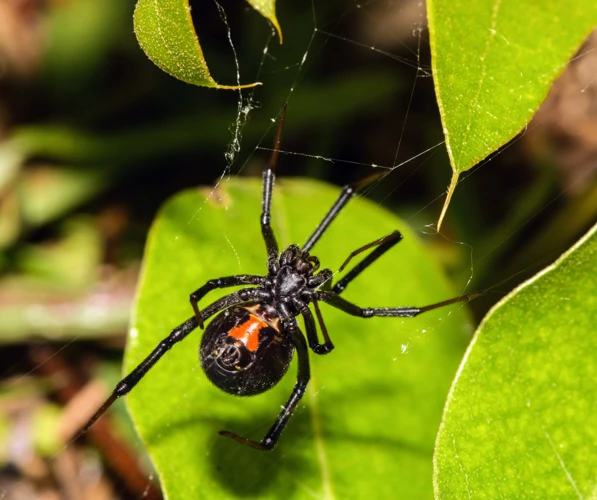
The territorial behavior of black widow spiders is a fascinating aspect of their lives. While male black widow spiders tend to wander in search of females with whom to mate, females are territorial and will defend their space against rivals. Understanding the factors that influence black widow spider territoriality is essential to unraveling the mysteries of this unique behavior. Let’s delve deeper into the various influences that impact the territorial behavior of these venomous spiders. For a better understanding of black widow spider territoriality and their behavior, you can refer to our article on black widow territorial behavior or the territory of female black widow spiders. Additionally, to get a comparative insight, you can check how other species of spiders display territorial behavior.
Genetics
Influencing factors in black widow spider territoriality include genetics, environment, mating, and competition. Genetic factors in black widow spiders are complex and can have significant impacts on territoriality. Here are some of the ways genetics can affect black widow spider territoriality:
- Gene Expression: Gene expression plays a crucial role in black widow spider territoriality. Studies show that there are numerous genes that are expressed differently in black widow spiders that exhibit territoriality than in those that do not. Some genes may increase aggression and territorial behavior, while others may decrease it.
- Receptor Sensitivity: The sensitivity of certain receptors in black widow spiders can increase their territorial behavior. For instance, increased sensitivity to pheromones can make black widow spiders more aggressive towards rivals and other potential threats.
- Behavioral Traits: Certain behavioral traits linked to territoriality may be inherited in black widow spiders. For example, there may be genes that cause some spiders to be more likely to defend their territory against rivals, while others may be more passive and less likely to fight for their territory.
The genetics of black widow spiders is complex and not fully understood. However, research shows that genetics can play a significant role in black widow spider territoriality by influencing gene expression, receptor sensitivity, and behavioral traits.
Environment
The environment plays a crucial role in determining the territoriality of the black widow spider. A spider’s environment includes its habitat, the availability of resources, and the challenges presented by the surrounding ecosystem. Here are some of the environmental factors that can impact the territorial behavior of black widow spiders:
- Habitat: Black widow spiders are often found in dark, secluded places such as crevices, burrows, and under rocks. The nature of their habitat shapes their territorial behavior, as they tend to defend their own territory against intruders.
- Resources: The availability of food and water can greatly influence the territorial behavior of black widow spiders. With abundant resources, spiders are more likely to establish a fixed territory and defend it aggressively. On the other hand, in times of scarcity, spiders may be more likely to share and cooperate in order to survive.
- Competition: In crowded habitats with many other spiders or predators, black widows may have to compete more fiercely for resources and may be more aggressive in defending their territory.
It’s worth noting that while genetics heavily influence black widow spider territoriality, environmental factors can also affect gene expression and behavior. For example, a spider that experiences a lack of resources in its environment may express genes that favor cooperation rather than aggression, leading to a more tolerant territorial behavior.
All in all, understanding the environmental factors that influence black widow spider territoriality can help researchers better understand the behavior of these fascinating creatures and how they interact with their surroundings.
Mating
Mating is another factor that influences black widow spider territoriality. Male black widow spiders often search actively for females, and their presence may lead to increased aggression and territorial behavior in females.
During mating, male black widow spiders initiate copulation by using pedipalps to transfer sperm to the female’s genital opening. The male must then retreat quickly to avoid being attacked and devoured by the female. This process can be risky for the male, especially if the female is in an aggressive or territorial state.
Interestingly, research has shown that mating with multiple males can influence black widow spider territoriality. When a female mates with multiple males, it can increase competition between the males and lead to increased aggression and territorial behavior in the female towards other females.
Other studies have indicated that the act of mating itself can cause changes in the female’s behavior, specifically in her aggression towards potential prey. After females mate, they tend to become more aggressive hunters, potentially due to an increase in energy and hormone levels following successful copulation.
It is important to note that there are individual variations in black widow spider behavior, and not all mating situations will result in increased aggression or territoriality. However, mating remains a significant factor in understanding and analyzing the complex behaviors exhibited by these venomous spiders.
Factors such as genetics, environmental factors, population density, food availability, and climate can all come into play when examining black widow spider territoriality. By understanding the various factors that contribute to this behavior, scientists can help develop methods for managing and controlling these potentially dangerous arachnids.
Competition
Competition is a crucial factor in Black Widow Spider Territoriality. When resources are scarce, the spiders have to compete for food and shelter. The competition can lead to territorial disputes, which often result in fights between individuals.
Types of Competition:
The competition can be either intraspecific or interspecific. Intraspecific competition occurs between individuals of the same species, while interspecific competition occurs between individuals of different species. In the case of Black Widow Spiders, intraspecific competition is more common, as they are solitary animals.
Impact of Competition:
Competition impacts Black Widow Spider Territoriality in many ways. High competition levels can lead to an increase in the number of territories, smaller territories, and increased aggression. The competition can affect gene expression, receptor sensitivity, and behavioral traits of the spiders.
Behavioral Adaptations:
Black Widow Spiders have developed various behavioral adaptations to deal with competition. They are known to be highly aggressive and will fiercely defend their territories. Additionally, they have developed intricate courtship displays, which allow them to attract mates and establish their territories.
| Competition Factors | Impact on Territoriality |
|---|---|
| Resource Availability | High competition leads to smaller territories and increased aggression |
| Population Density | Increased population density leads to increased competition and more territories |
Conclusion:
Competition plays a significant role in Black Widow Spider Territoriality. It affects their behavior, gene expression, receptor sensitivity, and territorial dynamics. Understanding the impact of competition can help us better protect their habitats and ensure their survival in the wild.
How Genetics Affects Black Widow Spider Territoriality?
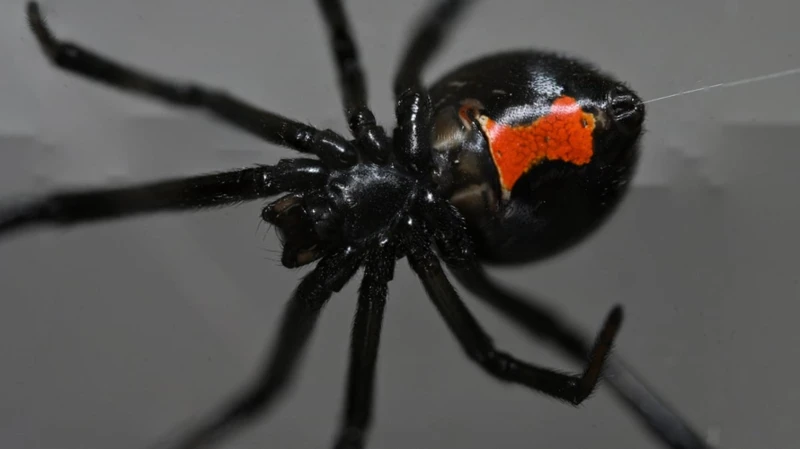
When it comes to territorial behavior of black widow spiders, genetics plays a significant role. The interaction between genes and the environment can lead to variations in key behavioral traits, such as aggressiveness and territoriality. In this section, we will explore the mechanisms by which genetics affects black widow spider territoriality, highlighting the importance of gene expression, receptor sensitivity, and behavioral traits in this process. Join us in unraveling the complex relationship between genetics and territorial behavior in these fascinating arachnids.
Gene Expression
Gene expression is a fundamental aspect that influences the territoriality behavior of black widow spiders. The expression of certain genes can modify certain behaviors, including the territorial instinct. According to recent studies, the expression of certain genes, such as the octopamine receptor gene, is higher in spiders that exhibit more territorial behavior.
Octopamine receptor genes play a significant role in regulating aggression and territoriality in black widow spiders. These receptors are responsible for receiving octopamine, which is a neurotransmitter involved in various physiological processes. Black widow spiders with a higher level of octopamine receptor genes tend to be more aggressive and territorial than those with lower levels of expression.
Scientists have discovered that the expression of certain genes can be influenced by the environment, including the availability of resources and population density. For example, spiders raised under conditions of low food availability tend to exhibit a higher level of territorial behavior, which is believed to be related to the expression of the octopamine receptor gene.
The following table gives an overview of the genes that are responsible for regulating territorial behavior in black widow spiders:
| Gene Name | Function | Expression Level in Territorial Spiders |
|———–|———-|—————————————-|
| Octopamine receptor gene | Regulates aggression and territoriality | High |
| Serotonin receptor gene | Regulates mood and behavior | Low |
| Dopamine receptor gene | Regulates motivation and reward | Low |
| Neuropeptide F gene | Regulates feeding and stress response | High |
| Crustacean cardioactive peptide gene | Regulates locomotion | Low |
As shown in the table, the expression level of each gene varies depending on its specific function. Interestingly, the expression level of the serotonin receptor gene, which regulates mood and behavior, is lower in territorial spiders. This indicates that aggression and territoriality are not related to changes in mood but are a result of specific genetic and hormonal functions.
Gene expression is a crucial aspect of black widow spider territoriality behavior. The expression of certain genes, such as the octopamine receptor gene, can modify behavioral traits, leading to an increase in territorial behavior. Further research is needed to fully understand the complex relationship between genetics and behavior in black widow spiders.
Receptor Sensitivity
Black widow spiders have sensory cells located in their legs called chemoreceptors. These chemoreceptors help black widows in detecting prey, mates, and also in marking their territory. Research suggests that variations in the sensitivity of these chemoreceptors depend on the genetic makeup of the spider.
Specifically, studies have shown that changes in the expression of certain genes in black widows can modulate the sensitivity of their chemoreceptors. This modulation can have a significant impact on their territorial behavior. For example, spiders with a higher sensitivity to certain compounds may be more likely to be aggressive towards intruders, as they are more aware of foreign odors and chemicals in their territory.
In addition to genetic influences, other factors such as the age and size of the spider may also affect its receptor sensitivity. For example, research has found that the expression of chemoreceptor genes varies across different stages of the black widow’s life cycle.
Receptor sensitivity plays a crucial role in black widow spider territoriality. By modulating their sensitivity to specific chemoreceptor cues, black widows can detect and respond to changes in their environment and protect their territory from intruders.
To summarize the information discussed above, please refer to the table below:
| Factors | Impact |
|---|---|
| Genetic variations | Modulate the sensitivity of chemoreceptors, leading to different territorial behaviors |
| Age and size | May affect the expression of chemoreceptor genes and overall receptor sensitivity |
Understanding the impact of receptor sensitivity on black widow spider territoriality is important for comprehending their behavior and also for developing effective ways to control their populations in areas where they pose a risk to humans.
Behavioral Traits
The behavioral traits of Black Widow spiders play a significant role in their territoriality. These spiders are known to exhibit aggressive behavior towards other spiders, especially when they feel their territory is being invaded. These aggressive tendencies are driven by a combination of genetic and environmental factors, which contribute to their innate behavioral traits.
Marking their Territory: To signal their ownership of an area, Black Widow spiders use a unique type of silk known as dragline silk. This silk is coated in pheromones that tell other spiders that the area is taken. By marking their territory in this way, Black Widow spiders can avoid physical confrontations with other spiders.
Aggressive Defense: When their territorial boundaries are infringed upon, Black Widow spiders will display aggressive defense behavior. This behavior includes biting, chasing, and even webbing up intruders. The strength of these aggressive tendencies can vary depending on the individual spider’s genetic makeup.
Individual Differences: Like humans, individual Black Widow spiders can exhibit different behavioral traits. Some may be more territorial and aggressive, while others may be more relaxed and tolerant of other spiders. These differences can be attributed to variations in gene expression and receptor sensitivity.
Response to Threats: When feeling threatened, Black Widow spiders will often respond by retreating to a safer location. This is especially true when the intruder is larger or more aggressive than the spider. In these situations, Black Widow spiders will rely on their speed and agility to escape potential danger.
Black Widow spider territoriality is heavily influenced by their genetic makeup and behavioral traits. By marking their territory, aggressively defending it, and responding to threats, these spiders ensure that they have access to the resources they need to survive. Understanding the behavioral traits of Black Widow spiders is important for researchers and individuals who live in areas where these spiders are found to safely coexist with them.
Factors that Determine Black Widow Spider Territoriality?
When it comes to determining the territoriality of black widow spiders, there are various factors that come into play. These factors can range from population density to the availability of food, and even the climate of the environment in which they reside. Understanding these factors and how they impact territorial behavior is crucial in identifying and predicting spider behavior. Let’s explore each of these factors and their role in determining the territoriality of black widow spiders.
Population Density
The population density of Black Widow spiders is one of the key factors that determine their territoriality. When there are more spiders living in a certain area, they tend to compete more fiercely for resources such as food, water, and space. This results in a higher level of aggression and territoriality among Black Widow spiders, as they try to establish and defend their own areas.
Strong competition among black widow spiders for a limited food supply can lead to mortality and cannibalism. To illustrate the importance of population density in shaping the territorial behavior of Black Widow spiders, we can examine some studies. Research has shown that in areas of high population density, Black Widow spiders exhibit more aggressive behavior, fighting more often and more fiercely with their neighbors.
In contrast, when the population density is low, Black Widow spiders tend to be less aggressive and more tolerant of neighboring spiders. They may even form communal webs, which allows them to cooperatively defend their territory while also sharing resources and space. This demonstrates that the level of aggression and territoriality among Black Widow spiders is closely tied to their population density.
It should be noted that population density is not the only factor that influences Black Widow spider territoriality. Other factors, such as food availability, climate, and life cycle, can also play important roles. For instance, during mating season, males often exhibit more territorial behavior in order to attract females. Despite this, population density remains a consistently important factor in shaping the territorial behavior of Black Widow spiders. Below is a table summarizing how population density affects the territoriality of Black Widow spiders.
| Population Density | Behavior |
|---|---|
| High | More aggressive, fights often and fiercely with neighbors |
| Low | Less aggressive, more tolerant of neighboring spiders, and can form communal webs |
Population density has a significant impact on the territoriality of Black Widow spiders. As with many other animal species, the level of competition for resources is closely tied to the level of aggression and territoriality that Black Widow spiders exhibit. It is important for researchers and other interested parties to consider population density as a key factor when studying Black Widow spider behavior.
Food Availability
The availability of food plays a crucial role in the territoriality of Black Widow Spiders. Studies have shown that regions with abundant food sources tend to have higher densities of Black Widow spiders, which in turn leads to more aggressive territorial behavior. The most common food sources for Black Widow spiders are insects such as grasshoppers, crickets, and beetles, and small vertebrates such as lizards and mice.
Factors that Influence Food Availability:
- Climate: The climate is an essential factor in the availability of food sources for Black Widow spiders. Regions with higher humidity levels and abundant rainfall tend to provide suitable habitats for insects, which serve as prey for Black Widow spiders.
- Vegetation: The type and abundance of vegetation in an area also play a crucial role in the availability of food sources for Black Widow spiders. Regions with dense vegetation tend to have higher densities of insects that serve as prey.
- Habitat Disturbance: Habitat disturbance caused by human activities such as agriculture, construction, and deforestation can negatively impact the availability of food sources for Black Widow spiders. This can lead to lower densities of insects, which in turn can lead to decreased territorial behavior of the spiders.
- Predator-Prey Relationships: The presence of predators can indirectly affect the availability of food sources for Black Widow spiders. In areas with high predator densities, prey populations may be reduced, which can impact the availability of food sources for Black Widow spiders.
- Population Density: The overall population density of Black Widow spiders in an area can also impact food availability. In areas with high densities of spiders, competition for food resources can increase, leading to more aggressive territorial behavior.
Food availability is a crucial factor that influences Black Widow Spider territoriality. Factors that affect food availability such as climate, vegetation, habitat disturbance, predator-prey relationships, and population density can impact the territorial behavior of Black Widow spiders. Understanding the role of food availability in Black Widow Spider territoriality can help in managing and conserving habitats where these spiders exist.
Climate
Climate plays an important role in the black widow spider’s territoriality. Temperature, humidity, and precipitation can all influence the spider’s behavior. The ideal temperature range for black widow spiders is between 70 and 85 degrees Fahrenheit. Higher temperatures can be stressful and cause a decrease in activity, while lower temperatures can slow down their metabolism, making them less active as well. In areas with high humidity levels, black widow spiders tend to be more active, while overly dry climates can cause them to seek shelter to conserve moisture.
Furthermore, precipitation can also play a role in black widow spider territories. Heavy rainfall can cause flooding, which can force the spiders to find drier areas to establish their webs. Droughts, on the other hand, can reduce the amount of available food and force spiders to expand their territories in search of prey.
Here is a table outlining the effects of different climate factors on the territoriality of black widow spiders:
| Climate Factor | Impact on Territoriality |
|---|---|
| Temperature | Optimal range between 70-85°F; extremes can decrease activity levels |
| Humidity | High levels can increase activity; low levels can cause spiders to seek shelter |
| Precipitation | Heavy rainfall can cause flooding, forcing spiders to find drier areas; drought can reduce available food and force territorial expansion |
It is important to note that climate is just one of many factors that influence the territoriality of black widow spiders. Genetics, environment, mating behaviors, and competition all play a role as well. Understanding these factors can help researchers and pest control professionals better understand and manage these potentially dangerous spiders.
Life Cycle
The life cycle of the black widow spider plays a crucial role in determining its territorial behavior. These spiders typically have a lifespan of one to three years, and their behavior changes as they mature.
During their first year of life, black widow spiders are wanderers and do not exhibit territorial behavior. However, as they develop into adults in their second and third years, they become more aggressive and territorial.
As female black widows reach sexual maturity, their territorial behavior becomes more pronounced as they compete for limited resources and potential mates. Male black widows also display territorial behavior, but their primary focus is finding a mate.
The mating season for black widows typically occurs in the late spring or early summer. Male black widows often wander into new territories in search of females to mate with, and their presence can increase competition among the female spiders.
Once the female has mated and laid her eggs, she becomes particularly aggressive in defending her territory. This is because the eggs and subsequent spiderlings represent a significant investment of energy for the female, and any threat to their survival can trigger a defensive response.
As the spiderlings hatch and emerge from the egg sac, they initially remain in close proximity to their mother’s web and display little territorial behavior of their own. However, as they mature, they begin to disperse and establish territories of their own.
The life cycle of black widow spiders is a complex process that influences their territorial behavior. Their behavior changes as they mature, and certain stages of their life cycle, such as mating and reproduction, trigger particularly aggressive territorial responses.
Conclusion
After years of research, it is evident that genetics play a crucial role in the territorial behavior of black widow spiders. Their genes are responsible for the expression of receptors, which ultimately determine their sensitivity to environmental cues that trigger territorial behavior. Additionally, the behavioral traits of black widow spiders are also influenced significantly by the interplay of different genetic factors. It is worth noting that environmental factors such as population density, food availability, climate, and their life cycle also play a significant role.
As the population of black widow spiders continues to increase and their habitats continue to be depleted, the understanding of their territorial behavior becomes essential. Understanding the role of genetics in their territorial behavior can assist in the development of strategies to conserve their habitat while ensuring the safety of those living in their vicinity.
Further research can focus on the interplay between genetic and environmental factors in black widow spider territorial behavior. Understanding the complex relationships between genetics and environmental cues will be vital in developing comprehensive conservation and management plans. By doing so, we can continue to learn more about these fascinating creatures and develop effective strategies to protect them and the environment they occupy.
Frequently Asked Questions
What is the scientific name for Black Widow Spider?
The scientific name for Black Widow Spider is Latrodectus.
Is Black Widow Spider territorial?
Yes, Black Widow Spider is territorial and will defend its territory against intruders.
What is the role of genetics in Black Widow Spider territoriality?
Genetics plays a significant role in Black Widow Spider territoriality as it determines their behavioral traits and receptor sensitivity.
How does the environment influence Black Widow Spider territoriality?
The availability of resources and suitable habitat can affect the territorial behavior of Black Widow Spiders.
What is the mating behavior of Black Widow Spiders?
Male Black Widow Spiders will approach the female’s web and initiate courtship, and after mating, the male may become a meal for the female.
Do Black Widow Spiders have competition for territory?
Yes, Black Widow Spiders compete for territory with other spiders and predators.
How does gene expression affect Black Widow Spider territoriality?
Different genes can determine the behavioral traits of Black Widow Spiders, including those related to territoriality.
What is receptor sensitivity, and how does it affect Black Widow Spider territoriality?
Receptor sensitivity refers to how sensitive the spider is to touch and chemical signals. Changes in receptor sensitivity can affect the spider’s territorial behavior.
How does population density affect Black Widow Spider territoriality?
Higher population densities can lead to increased competition for resources and space, which can affect the territorial behavior of Black Widow Spiders.
What role does climate play in Black Widow Spider territoriality?
The temperature and humidity of the environment can affect the activity level and behavior of Black Widow Spiders, which can, in turn, affect territoriality.

